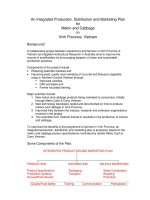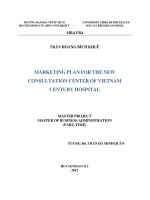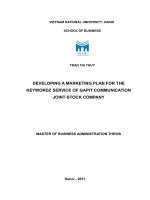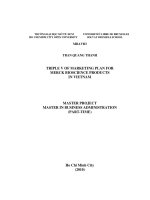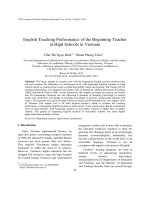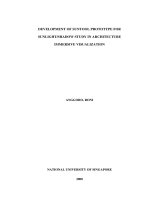Triple V of marketing plan for Merck Bioscience products in Vietnam
Bạn đang xem bản rút gọn của tài liệu. Xem và tải ngay bản đầy đủ của tài liệu tại đây (1.22 MB, 97 trang )
TRƯỜNG ĐẠI HỌC MỞ TP. HCM
HO CHI MINH CITY OPEN UNIVERSITY
UNIVERSITEÙ LIBRE DE BRUXELLES
SOLVAY BRUSSELS SCHOOL
MBAVB3
TRAN QUANG THANH
TRIPLE V OF MARKETING PLAN FOR
MERCK BIOSCIENCE PRODUCTS
IN VIETNAM
MASTER PROJECT
MASTER IN BUSINESS ADMINISTRATION
(PART-TIME)
Ho Chi Minh City
(2010)
3
CERTIFICATE
I certify that the substance of this project has not already been submitted for any degree
and is not currently being submitted for any other degree or qualification.
I also certify that, to the best of my knowledge, any help received in preparing this project,
and all sources used have been acknowledged in this project.
Signature: Tran Quang Thanh ______________________
Date: December 24, 2010
4
ACKNOWLEDGE
The successful completion of this research paper would have not been possible without the
help of many people. I would like to express my deepest gratitude to the following people:
Dr. Nguyen Duc Tri, tutor of my thesis, his valuable time and especially for his clear
guidance and correction to my thesis.
Dr. Axel Hartmann – my mentor, Mr. Tran Minh Le, and Mr. Phan Nguyen Quang Hung,
Merck’s colleagues, for their help with the reference documents, their consultation, support
and encouragement.
Finally, I would like to thank my beloved ones for their continuous encouragement to me
during my study.
5
6
TABLE OF CONTENTS
List of abbreviations ..................................................................................................... 8
List of tables................................................................................................................. 9
List of figures ............................................................................................................. 10
Chapter 1: Introduction
1.1 An introduction to Biosciences and their development........................................11
1.2 The Biosciences in Vietnam…………………………………………………….16
1.3 Merck Vietnam introduction…………………………………………………….21
1.4 Rationale…………………………………………………………………………22
1.5 Problem statement………………………………………………………………..23
1.6 Research objectives………………………………………………………………23
1.7 Scope of the study………………………………………………………………..23
1.8 Research structure………………………………………………………………..23
Chapter 2: Conceptual framework/Literature review
2.1 Marketing…………………………………………………………………………25
2.2 Triple values of a marketing plan…………………………………………………29
Chapter 3: Methodology
3.1 Research process…………………………………………………………………..36
3.2 Qualitative study…………………………………………………………………..37
3.3 Quantitative study…………………………………………………………………38
Chapter 4: Data analysis & findings
4.1 Reliability analysis……………………………………………………………...…44
4.2 Sample profile……………………………………………………………………..44
4.3 Descriptive analysis………………………………………………………………..52
4.4 Findings……………………………………………………………………………61
Chapter 5: Conclusions and recommendations
5.1 Conclusions………………………………………………………………………..65
5.2 Recommendations…………………………………………………………………66
5.3 Limitations of the study and future research………………………………………67
Appendices
Appendix A: Questionnaire in English & Vietnamese………………………………..68
7
Appendix B: The list of paid respondents for survey questionnaire…………………..75
Appendix C: Reliability analysis………………………………………………………76
Appendix D: Frequency tables………………………………………………………...81
Appendix E: ANOVA results………………………………………………………….90
Bibliography
8
LIST OF ABBREVIATIONS
MVN Merck Vietnam Company
R&D Research and Development
USD
United States Dollar
KDF Key discriminating factor
9
LIST OF TABLES
Table 3.3a: Research approach and methods
Table 3.3b: Extent of importance and company performance on each KDF
Table 3.3c: Actionmap of a decision maker
Table 4.2c: Descriptive analysis of project quantity by organization type
Table 4.2d: Sample distribution by literature source and organization type
Table 4.2e: Sample distribution by literature format and organization type
Table 4.2f: Sample distribution by budget source and organization type
Table 4.3b1: Important factors of satisfaction
Table 4.3b2: Mean of the 6 important factors by organizations
Table 4.3c1: Satisfaction about contact for purchase
Table 4.3c2: Satisfaction about delivery
Table 4.3c3: Satisfaction about order process and documents
Table 4.3c4: Satisfaction about products & services
Table 4.3c5: Satisfaction about value
Table 4.3d1: Extent of important KDFs
Table 4.3d2: Means of the 6 KDFs between organizations
Table 4.3e: Means of all competitors’ performance on each KDF
10
LIST OF FIGURES
Figure 1.3: MVN Business model
Figure 2.1a: Market flows
Figure 2.1b: Holistic marketing
Figure 2.1c: Value delivery process
Figure 2.2a: Common market segment variables
Figure 2.2b: Value network options
Figure 3.1: Research process
Figure 4.2a: Sample distribution by organization type
Figure 4.2b: Sample distribution by use purpose of chemicals
Figure 4.2c: Sample distribution by project quantity being joined
Figure 4.2g: Sample distribution by % budget for chemicals and org. type
Figure 4.2h: Sample distribution by each purchase and org. type
Figure 4.2i: Sample distribution by amount as per purchase and org. type
Figure 4.2j: Sample distribution by % use of Merck chemicals and org. type
Figure 4.2k: Sample distribution by Merck brands and org. type
Figure 4.2l: Sample distribution by % use of Merck biosciences and org. type
Figure 4.2m: Sample distribution by favorite promotion and org. type
Figure 4.2n: Sample distribution by promotion info channels and org. type
Figure 4.3a: End users’ actions
Figure 4.3b: Means of the 6 important factors by organizations
Figure 4.3c: Means of these composite factors by organizations
Figure 4.3d: Means of the 6 KDFs between organizations
Figure 4.3e1: Means of Merck performance on the 6 KDFs
Figure 4.3e2: All competitors’ performance on KDFs
11
CHAPTER 1: INTRODUCTION
1.1 An introduction to Biosciences and their development
Biosciences have been identified in numerous contexts as one of the keys to
economic development in the years to come. With Infosciences and Nanosciences,
Biosciences constitute the real framework of the “New economy”.
Three principle features are common to these three scientific and technological
areas:
•
The capacity to integrate with one another.
•
The capacity to be a development key for other industrial sectors and
therefore to “enable technologies”.
•
The fact of being “world-wide” and “global”.
However, along with these similarities, the three scientific areas show great
differences in the way they grow, develop, and in their impact on local economies.
A basic definition of Biosciences will help to understand the main players in the
sector and the way they and their different technologies converge and interact, and
will also serve as a key to understanding the problems of development in this sector.
Defining life sciences and biotechnologies
The difficulty of defining biotechnologies lies in their diversity. In fact, life
sciences and particularly biotechnologies comprise a range of multidisciplinary
technological platforms and scientific discoveries that can be combined in different
and innovative ways as and when required.
To this regard, biotechnologies can be defined as “every technology that uses live
organisms (such as bacteria, yeasts, vegetable cells, simple or complex organism
animal cells) to obtain commercial quantities of useful products, or to improve
animal and plant characteristics or to develop useful micro-organisms for specific
use”. This general definition also includes production technologies used long ago,
such as agriculture, zootechnology and the exploitation of fermentation activities of
microorganisms. The latter can therefore be distinguished by grouping them under
the term traditional biotechnologies, to differentiate them from the truly innovative
biotechnologies.
12
From this point of view, innovative Biotechnologies are clearly the result of basic
and explorative research. In this field, what is clearly evident is the close
relationship between basic research and applied research and production, in
contrast to the traditional concept of basic research taking place uniquely in
universities, and applied research and production taking place in industry.
In times of globalization of information, this unique feature is bound to influence
the key factors of development, and explains why real “biodistricts” come into
being in specific areas.
The same multidisciplinary origin of biotechnologies partly explains their
applications in different industrial sectors. Some examples of biotechnological
applications deriving from life sciences which have become innovative processes in
industrial production are:
•
Human health (Pharmaceutical, diagnostics)
•
Agricultural
•
Zootechnology
•
Cosmetics
•
Bioindustry and chemical
•
Environmental and energy
The integration of these technologies with infosciences and nanosciences opens
further, exciting and new development areas in synergic sectors, such as
bioinformatics, biomedicine, etc. The biotechnologies system therefore, is
particularly rich and complex. However, these remarkable biotechnologies have
brought with them moral, ethical and legal implications, (for instance, consider the
problem of patents).
Biotechnology industry: a structural analysis of the sector
“Towards an economy founded on knowledge”
In industrially advanced societies, the creation of wealth deriving from knowledge
and product quality becomes increasingly important, while at the same time the
13
prominence of classical parameters, such as the cost of raw materials and labor
costs, decreases.
The “society of knowledge” gives rise to a new economy, capable of creating high
value added products.
The following three sectors are the most characteristic of this new trend:
information technology, nanotechnologies & new materials and biosciences.
Biotechnology, as we have seen, includes a wide range of technologies and
procedures that foster the creation of highly competitive new products and
processes in numerous industrial, agricultural and health sectors, leading to new
opportunities in many sectors.
Biotech products in fact distinguish themselves as being easily incorporated in
multidisciplinary “technological solutions” that can be applied in different fields.
In order to understand the importance and impact of the biotechnology sector, one
must start with a “economy based” definition.
According to some analysts “Biotechnology is selling biology”. This concept seems
to be fully understood in many countries where by now biotechnologies represent
an explicitly strategic market, so much so that many leading international scientists
and economists argue that the century which has just begun will be called “the
biotechnology century”. The revolutions in genetic and computer science have
merged to form a “scientific, technological and commercial phalanx”, namely a
new reality that promises to deeply influence both the individual and society.
Biotechnology sector
In the last few years in industrialized countries, the biotechnology sector has shown
striking economic growth impacting directly on the quality of life and on socioeconomic development.
This sector has been characterized by at least three relevant factors: a high
technical-scientific content in rapid and continuous evolution, close links with basic
research (therefore with University and other institutions) in which biotechnologies
are deeply rooted, and the long time needed to introduce a new product on the
14
market (which today varies between 5 to 10 years, for almost all sectors of
application).
Research
Research is the principal source of new ideas that, once developed, can lead to the
commercial exploitation of new products or productive processes and/or their
improvement.
It includes mainly research carried out in public and private research structures,
although it can also involve industrial research partners. As a rule, companies use
research results only if they are potentially marketable. In order to become a
process and a product of innovation, research depends, above all, on the process of
technology transfer and the creation of new enterprises.
Biotechnology specialized enterprises (ISB)
The “ISB” appear to be the most incisive in converting scientific discoveries into
services and products with a commercial value. Essentially, there are three types:
a) Developing enterprises: are proprietors of an idea engaged in converting it into a
product or service of a precise commercial value. Many of them, in particular in the
medical-healthcare sector, are involved through investments and joint ventures with
larger sized enterprises. This strategic approach is also adopted by large
pharmaceutical industries, due to the opportunity it offers of making use of research
and development activity results produced elsewhere;
b) “Integrated activity” enterprises: are enterprises that have invested in research,
development, production, marketing and sales. With the exception of new
companies in the diagnostic sector, and Amgen, Genentech, Serono and Genzyme
in the pharmaceutical sector, there are relatively few of them;
c) Suppliers: are companies that supply equipment, materials and services either to
companies which operate strictly in the biotechnology field or for end user
companies. This type of firm is becoming increasingly more important because of
the need for companies to use technologies and services which are not available in
house.
15
Biotechnological industry convergence
Biotechnology has had the opportunity to become one of the most dynamic
phenomena of this century, thanks to the convergence of numerous forces from
different sectors.
Biotechnology is in fact creating extensive platforms for new products and markets
on various fronts (from agriculture to chemical and industrial processes, from
medicine to informatics) with many companies that relocate and integrate their
scientific approaches and financial objectives.
The convergence between previously distinct industries is taking place rapidly, and
this could eventually lead to a more stable and sustainable biotechnological market.
If this trend continues, the dividing line between biotechnological and industries of
other sectors will be less evident, increasing the number of new hybrid products.
The biotechnological industry, apart from giving rise to the production of many
new drugs for man, is increasingly interacting with non-traditional sectors, such as
chemical products, semiconductors, information technology, and agriculture. Many
of these industries have begun to take advantage of the power of biotechnologies,
and numerous companies operate contemporaneously in many different sectors.
Keys to local development in the Biotechnological sector
All these factors help us understand how development in the biotech sector is
subject to a high number of variables. The European Commission16 has identified
numerous factors that come into play when the problem of how to encourage
growth in this sector is encountered. Briefly, the key elements identified are the
following:
•
the presence of a strong scientific base;
•
the capacity to transform scientific research results into innovations;
•
social impact;
•
alignment with social values;
•
adoption of demand oriented solutions through an informed choice;
16
•
reliability of scientific instruments on which regulatory boards base their
criteria;
•
shared and transparent regulatory principles;
•
belonging to international networks.
Having analyzed the biotechnology sector in terms of type of enterprise and the
importance of convergence/integration phenomena, the variables identified can be
interpreted in the light of the future prospects they represent, as a range of
strategies and as industrial policy, starting with the assumption that “in spite of the
tendency towards broad internationalization of research, high technological
performance tends to be tied to “home-based” research capacity (Chemistry Today).
1.2 The Biosciences in Vietnam
The bio-innovation system in Vietnam: a brief overview
The structure and actors
Overall, R&D activities in Vietnam are organized into three main domains:
research institutes of the National Research Center which is now called the
Vietnam Academy of Science and Technology (VAST), research institutions under
line ministries such as the Ministry of Agriculture and Rural Development or the
Ministry of Health, and bioscience and biotech faculties and departments of
universities. There are about 50 research institutes and centers dealing with
bioscience and biotech in three areas of agriculture, including aquaculture,
healthcare and the environment.
The Ministry of Science and Technology, other ministries, and provinces have
created a network of biotechnology laboratories for research, technology
development and application. To date, this network includes 60 laboratories and
research units located throughout the country. The Ministry of Science and
Technology also provided the ministries with fund to establish and strengthen
equipments for more than 30 laboratories. Investment for last few years has been
about 80 billion VND (about 5 million USD). In addition, there are 30 simple
experiment units of tissue culture in almost all provinces, with investment of
17
30,000 USD provided by the Ministry of Science and Technology through
programs on science and technology application to support rural-mountainous
development. In the coming period, upgrading and reorganization of these units are
expected to result in investment estimated at about 5 million USD, an average of
130,000 USD per unit.
In 2002, in preparation for further biotechnology development in Vietnam the
Prime Minister decided to build 5 national key biotechnology laboratories and more
recently to invest in supplementary national laboratory of tissue culture technology
in the South. These six national key biotechnology laboratories and 60 other
laboratories and research units are the backbone of biotech research and training.
In universities, the system of biotechnology and bioscience mainly focuses on
teaching, with less emphasis on research. The Ministry of Education and Training,
other ministries and S&T organizations have various training programs for
Bachelors, MSc, and PhD of biotechnology in several formats. Around 12
universities have created training programs and centers of biotechnology. So far,
training has been conducted for more than 4,000 staff, of which 1,500 obtained
bachelors degrees, 400 MSc degrees and 90 PhD degrees. But this training has not
met the demand, especially in the major fields of biotechnology such as genetic
technology, cell technology, enzyme-protein technology and microorganism
technology. Along with universities, R&D institutes have also participated in
training biotechnological staffs. During the 5-year period from 1996 to 2000, 23
MScs and 22 PhDs have been trained through this research program.
As for overseas training and programs of internships, MSc and PhD training has
been carried out with State budget funds of 100 billion VND per year (or around 7
mln. USD). Through the Ministry of Education and Training more than 30 persons
have been trained in biotech areas. In the framework of national research programs
on science and technology, hundreds of biotechnology staff have collaborated with
colleagues from developed countries through visits or research projects. In addition,
scientists from overseas have been invited to Vietnam to train in research
methodology with more than 200 groups of Vietnamese biotechnology scientists. In
two recent years, Vietnam has also relied on some overseas scholarship schemes to
send students to the US, Europe, Australia, Japan for training.
18
Performance
In agriculture, Viet Nam has implemented artificial insemination, preservation
technology, embryo transfer and vaccine production technology. Technologies of
forming new breeds such as tissue culture and cell generation have been applied
widely in the production of rice, hybrid rice, maize, etc. Up to now, the
contribution of biotechnology to Vietnamese agriculture has resulted in selfsufficiency of 25% demand of F1 hybrid rice, generating economic benefits of 3050 million USD per year. New rice production has partially contributed to
Vietnam’s attainment of second position in the world rice export. New rice
varieties produced by local scientists are used in 70% of rice-cultivated area.
Biotechnology has also begun to generate aquaculture species and preventing
disease such as prawn species.
In health care and pharmaceutical products, for the last few years, artificial
insemination technology has been applied widely at some clinics in Ho Chi Minh
City and Hanoi. Genetic technology, DNA and protein chip are also explored in
some research institutions and health care centers. They have applied fast diagnosis
and early diagnosis technology in dealing with heredity problems in newborn
babies and the prevention of epidemics such as poultry flu, and dengue fever.
The research projects for vaccine production have produced the most significant
results in the field of medical biotechnology. Vietnam has mastered the technology
and produced 9 out of 10 kinds of vaccine to serve comprehensive vaccinated
programs. Two types of vaccines have met 100% of demand and the remained have
met 40-60% of demand in Vietnam.
Problems
In general, over the last 10 years, a system of laboratories from central to local
levels has been established with relatively modern equipment. However, the
operation expenditure is insufficient because there were no guidance on strategic
tasks and no sufficient link between theory and practical production. Hence, the
application of newly invested laboratories still has poor efficiency.
19
R&D on biotechnology has focused mainly on national key biotechnology
programs. No realistic priority for the key program has been designed, with the
research content designed primarily according to the existing background of the
scientists. There has been a lack of market driven real need. For instance, a scientist
with background in enzyme technology would propose strongly to develop research
base (a program, an enzyme laboratory) in their respective area, and so on. As a
result, though the results of research were deemed complete, not all of them have
been implemented in production.
The role of enterprises, especially of private-sector enterprises in biotechnological
research and application is weak and unclear. The driving force for development
and competitive capability of the state-owned enterprises in biotechnology has also
been weak. The system linkage among factors in the biotechnological innovation
system (e.g. enterprises, institutes and universities), similarly in many other areas
of innovation, has not been firmly seen. The current relationship between R&D
organizations and enterprises is experiencing some constraints, such as a shortage
of funds and capable human resources by the enterprises, in their collaboration with
R&D institutions and their own conducting of R&D. When cooperating with
foreign firms, Vietnamese firms tend to follow the initiative of their partners.
Vietnam still lacks the linkage and cooperation amongst scientists, as well as
qualified research teams having international level of research capability. This has
occurred despite the organization of several research programs.
Training also still has many shortcomings. In fact, there is lack of a well-designed
strategy and specific structure for training programs.
The bio-product market and demand for biotechnology development and
biotechnological industry have been not developed. It has not made the critical pull
for the biotechnological industry. The production base is narrow, bound to the
national market via the primary, unprocessed bio-related product demand, which
consists of mainly raw materials as tea, coffee, rubber, rice and aquaculture. This
kind of products has enjoyed only temporary comparative advantage and has weak
long-term competitiveness.
The policies and institutional framework for biotechnology and biotech industry
have not been developed in a conducive manner. The resolution of Vietnamese
20
government dated on March 11th, 1994 for biotechnology development until 2010;
the decision 54/QD-TTg for developing the techno-economic program on
biotechnology, despite all these efforts, current policies are deemed unclear and not
specific enough to make an impact on biotech development.
For international cooperation, the government has encouraged organizations to
employ both international experts or overseas Vietnamese with high professional
qualifications as consultants or take part directly in development planning, training,
and R&D activities. The government has also encouraged and financed
international joint programs. Still, there is a view that these incentives are not
sufficient for attracting more international involvement in innovation activities in
the country. These factors, however, will have implications for future bioscience
and biotech development of Vietnam.
Biotechnology is one of seven key technology fields which is intensive investment
by the Vietnamese government only. Total investment on biotechnology estimated
USD 100 million (Biotechnology 2003). Only 15% of expense amount accounted
for laboratory instruments and chemical products. Meaning that, its market size was
only round USD 15 million.
Bio-technology industry to be expanded (Vietnam News 2008)
The aim is to produce high-quality products and reach the level of the rest of the
ASEAN community by 2020. Under the plan, the Government will focus on
developing, and applying bio-technology in the areas of agro-forestry, fisheries,
food processing, food safety and sanitation, and healthcare and drugs.
The plan also aims to set up an open market to help bio-tech businesses promote
production and services in the next two years.
From 2011 to 2015, the Government will build a number of scientific research
centres for bio-tech development at the ASEAN level. The educational leader has
stressed the need to train qualified human resources for the bio-tech industry and
build international standard bio-tech development centres by 2020.
21
To meet staff demand, deputy prime minister urged the industry to train 20,000
university graduates and 2,500 post-graduates and to send 400 scientific workers
abroad.
The deputy also asked the industry to speed up the application of bio-tech research
in many industries, including agro-forestry, fisheries, food and beverages, plant and
animal hybrids, bio-fertilisers, and vaccines and other drugs.
The master plan encourages private enterprises to invest in development of the biotechnology industry by offering incentives. They include preferential rates on taxes,
land rentals and bank loans to help the industry promote, transfer and import
modern technology, and establish a favourable market for bio-technical services as
well as training bio-tech scientists.
1.3 Merck Vietnam introduction
Merck for Biosciences provides a range of life science research products (e.g.
antibodies, biochemicals and inhibitors and peptide synthesis reagents) of our
brands Calbiochem, Novabiochem, and Novagen, that are used worldwide in
university laboratories as well as in pharmaceutical and biotech industries. The
company offers innovative solutions at the cutting edge of research. (Merckchemicals)
Figure 1.3: MVN Business model
Customer services +
In-bound logistics
Dealer 1
+
Dealer 2
Out-bound
logistics
Dealer n
Small dealers
Enduser 1
Enduser 2
Enduser n
22
According to the business model above, the company does not sell directly to end
users, sales and marketing staffs manage directly end users. Traders (dealers and
small dealers) sell directly to end users.
Characteristics of chemicals market are price conscious (sensitive), labor intensive
with competitive product quality, and very low budget for R&D activities.
Merck’s positioning is premium brand (high price) and high quality products. Main
applications are in laboratory use chemicals. Our 2 brands being used in Vietnam
are Calbiochem and Novagen. A sale in 2009 was around USD 13,000, only
achieved below 1% of market size. The four direct competitors are Sigma, Qiagen,
Bio-rad, and Invitrogen
.
1.4 Rationale
After 15 years in Vietnam as a representative office, Merck Vietnam Company,
marketing and sales of chemical products has founded in 2010. One key target for
the new company will be the exploration of the chemical market for biotechnology,
bioscience products, in Vietnam to drive further strong growth of this promising
high-margin business. However, the company has not yet developed a marketing
plan to approach this market. Therefore, the need for using the triple-V approach to
marketing to define the three values: value segment, value proposition, and value
network results in a call for this study, as a result, the marketing plan will be
developed. In other words, according to sales and marketing director, the study
should be able to answer 3 questions such as 1) Sell to whom? 2) How to sell? and
3) How big of target segments?, is it worthy to sell into those segments?
23
1.5 Problem statement
The biotechnology market in Vietnam is very diverse and it’s at an infant stage of
market development. Major potential customers are in R&D units of hospitals, state
funded research institutions, universities and R&D departments of specialized
companies. Merck Vietnam did not establish a strong business in the growing
Vietnamese biotechnology market yet. It is lacking market insight and access.
Consequently, Merck’s business in this market is still small and stagnating. To
address this problem, the triple-V approach to develop a marketing plan will be
applied to achieve the company’s target. Therefore, relevant questions to be
answered by this study are:
1. Value segment or who to serve (valued customer)?
2. Value proposition or what to offer to the valued customers?
3. Value network or how to deliver the value proposition to the valued customer?
1.6 Research objectives
The study is designed to provide answers to the above questions, based on which
appropriate marketing strategies and policies may be developed. The research
objectives are to define the triple values such as value segment, value proposition
and value network. As a result, it will provide valuable inputs for marketing
strategy, plan and decisions.
1.7 Scope of the study
Major potential customers are in R&D units of hospitals, state funded research
institutions, universities and R&D departments of specialized companies. Most of
them located in Ho Chi Minh and Ha Noi city, therefore only these potential
customers were surveyed.
1.8 Research structure
This study report is presented in five chapters. Chapter 1 introduces biosciences
industry and their development, biosciences in Vietnam, Merck Vietnam
24
introduction, rationale, problem statement, research objectives and as well as scope
of the study. Literature review is presented in chapter 2. Chapter 3 describes the
methodology applied in the study. Data analysis and findings are presented in
chapter 4. Chapter 5 provides recommendations and recommendations.
25
CHAPTER 2: LITERATURE REVIEW
2.1 Marketing
The scope of marketing – What is marketing? (Kotler 2002)
Marketing deals with identifying and meeting human and social needs. It is about
“meeting needs profitably”.
Marketing is an organisational function and a set of processes for creating,
communicating and delivering value to customers and for managing customer
relationships in ways that benefit the organisation and its stakeholders.
Marketing management is the art and science of choosing target markets and
getting, keeping and growing customers through creating, delivering and
communicating superior customer value.
The aim of marketing is not selling. It is to know and understand the customer so
well that products and services fits him and sells itself.
Marketing is everywhere – it is embedded in everything we do. And it has become
a key ingredient to business success. Marketing is both an “art” and a “science”
and good marketing is no accident. It takes careful planning and execution.
Exchanges and Transactions
Exchange is a key concept in marketing. It is the process of obtaining a desired
product from someone by offering something in return. It is a value creating
process because it leaves both parties better off. 5 conditions must be satisfied in
this scenario such as 1) There must be at least 2 parties, 2) Each party has
something of value to the other party, 3) Each party is capable of communication
and delivery, 4) Each party believes it is appropriate and desirable to deal with the
other party.
Transaction is a trade of value between 2 or more parties. Transactions need at
least 2 things of value, agreed-upon conditions, a time and a place of agreement.
This differs from a transfer where A gives to B without anything tangible in return.
Marketing consists of actions undertaken to elicit desired responses from a target
audience. To be successful in marketing, marketers need to understand what each
party expects from the transaction.
26
Markets
In marketing terms, a market is used to describe the various groupings of customers.
Categories of markets include: Product market, demographic market, needs market
etc. In a market, there are many buyers and sellers. They are connected by 4 flows
as the figure 2.1 a below
Figure 2.1a: Market flows
Communication
Industry
(a collection of
sellers)
Goods / services
Market
(a collection of
buyers)
Money
Information
And there are 4 key customer markets: consumer (selling to the masses), business
(selling to business), global (selling in the global marketplace), and non-profit and
government (selling to churches, universities etc). Today we differentiate the
marketplace (physical) and the marketspace (digital). There is also the concept of
the metamarket: cluster of complementary products and services in the minds of a
consumer but spread across a diverse industry.
Company orientation towards the marketplace
There are 5 competing concepts under which organisations conduct marketing
activities:
1) Production concept – states that consumers prefer products that are
widely available and inexpensive. Therefore focus on high production, low
cost and mass distribution;
2) Product concept – Consumer favour quality, performance or innovation.
Therefore focus on superior products and constant improvement;
3) Selling concept – consumers will not buy enough if left on their own.
Therefore focus on aggressive selling and promotion;
